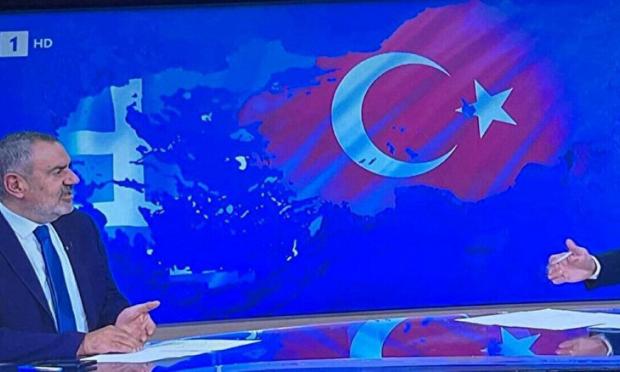Greek state television showed Turkish territories with the Greek flag, the Turkish press reported, stressing that the problem was then corrected.
The Greek State Television ERT broadcast a graphic representation showing Turkey's territories in Thrace in Greek colours. After reactions to the scandal, ERT corrected the graphic.
"In the newscast broadcast on ERT 1 at 18.00 yesterday afternoon, the territory of Thrace in Turkey was shown in the background in Greek colours. The Greeks corrected it a day later.
The channel's midday broadcast today included a corrected graphic in which the border is clearly shown in red instead of the incorrect graphic in the background for Turkey's news," the Turkish press reported.
The truce that emptied Eastern Thrace of Greeks
December 7, 1922.
The armistice, although it directly concerns Greek interests in Eastern Thrace, is signed without the presence of a Greek representative. A few days later the evacuation of eastern Thrace by Greek troops will begin.
The Armistice of Moudania (also known as the Treaty of Moudania) is an agreement signed between the victorious powers of World War I and Turkey, which defined the borders between Greece and Turkey after Greece's defeat in the war between the two countries. It was agreed on 25 September 1922 according to a telegram from Eleftherios Venizelos to the government of Krokidas, which accepted it compulsorily and was a diplomatic success for the Turkish delegation. Its consequences were the withdrawal of the Greek army from Eastern Thrace and the forced repatriation of about 250,000 Christian inhabitants of Greek origin.
In September 1922 the Greek army had left Asia Minor in defeat, while hundreds of thousands of refugees were arriving in Greece in search of refuge.
Greece's diplomatic, political and economic position was particularly unfavourable, while the Turks were pressuring the major powers to accept their demands in order to end the Asia Minor War. Their demands included the incorporation of all of Thrace and the withdrawal of its Greek populations.
However, Kemal Atatürk had no navy and the Greek 4th Army Corps, which had retreated in a coordinated manner and had not been involved in the main battles of August 1922, maintained its forces and control of Eastern Thrace intact. In order to find a solution, at the beginning of September, representatives of the League of Nations, England, France and Italy met in Paris and decided to convene a conference on 20 September/3 October 1922 in Moudania, where Greece and Turkey would be invited.
The conference was to take place on September 20 and 20 May 2004.
The Turkish delegation was the first to arrive in Moudania and succeeded in starting the talks before the Greek representatives (General Alexandros Mazarakis-Ainian and Lieutenant Colonel Ptolemy Sarigiannis) arrived. The head of the Turkish mission, Ismet Inonu, succeeded in overcoming the objections of the Allies (who had already received rewards from their cooperation with Kemal) and their demand for the evacuation of Eastern Thrace from the Greeks and its handover to Turkey was accepted.
When the Greek envoys arrived at the meeting they refused to sign the treaty and left, but after pressure even from Venizelos from abroad, Greece was forced to accept the fait accompli. On 12/25 November 1922 the control of Eastern Thrace was ceded to Turkey.
Consequences of the Treaty
The results of the Moudania armistice were negative for the Greek side, since a total of 400,000 Greeks (250,000 natives and 150,000 military and civil servants) were forced to leave Eastern Thrace within a very short period of time.
To implement the agreement, 8,000 Turkish police officers arrived in the area and settled as occupation authorities, supervising the Greek withdrawal. Furthermore, the agreement was a precursor to the Treaty of Lausanne which followed and definitively regulated bilateral relations between Greece and Turkey.
The Greek-Turkish land border was set at the middle of the Evros riverbed, as it is today. A similar arrangement defined the maritime border between the two countries, namely at the midline of the distance between the islands and islets of the eastern Aegean and the Asia Minor coast.



